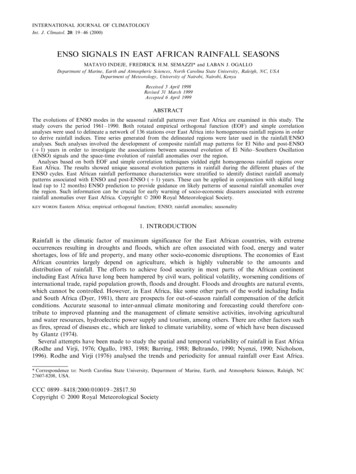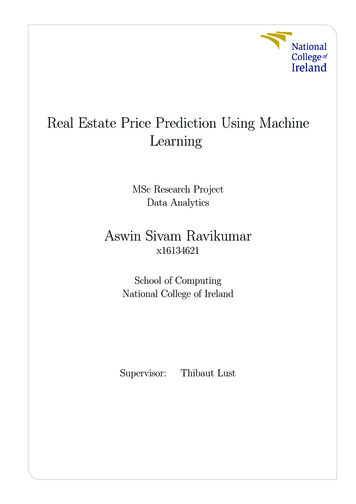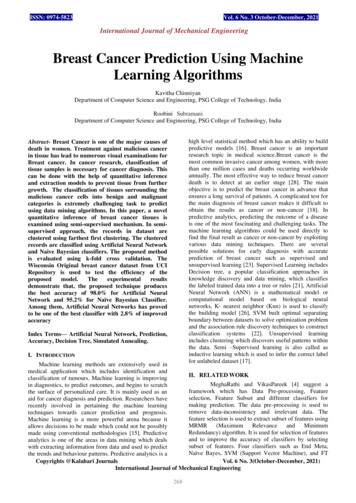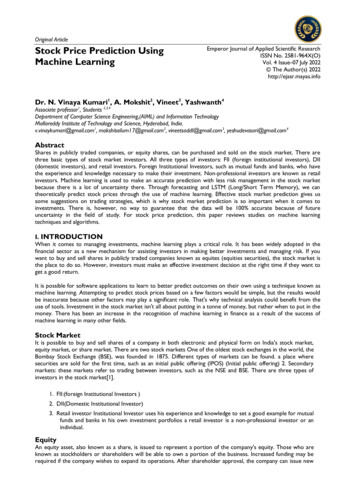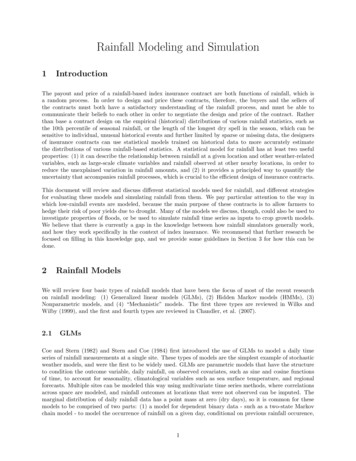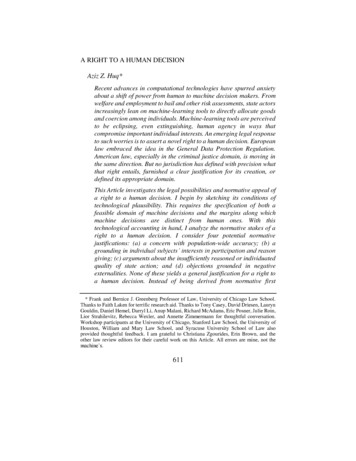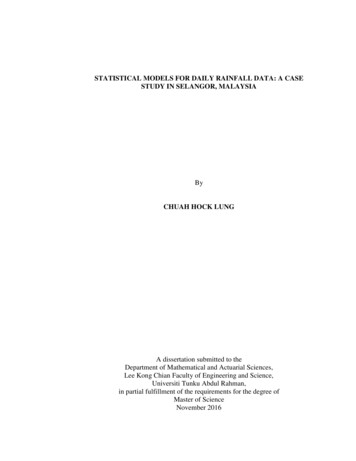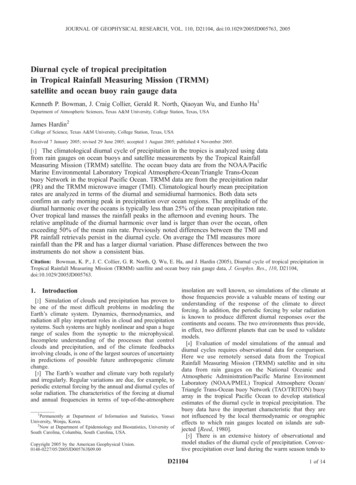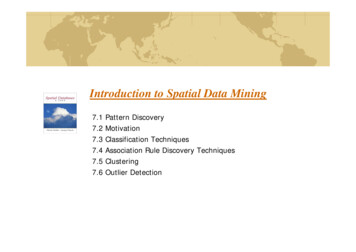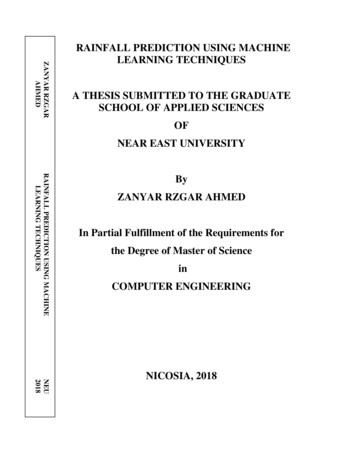
Transcription
ZANYAR RZGARAHMEDRAINFALL PREDICTION USING MACHINELEARNING TECHNIQUESA THESIS SUBMITTED TO THE GRADUATESCHOOL OF APPLIED SCIENCESOFNEAR EAST UNIVERSITYRAINFALL PREDICTION USING MACHINELEARNING TECHNIQUESByZANYAR RZGAR AHMEDIn Partial Fulfillment of the Requirements forthe Degree of Master of ScienceinCOMPUTER ENGINEERINGNEU2018NICOSIA, 2018
RAINFALL PREDICTION USING MACHINELEARNING TECHNIQUESA THESIS SUBMITTED TO THE GRADUATESCHOOL OF APPLIED SCIENCESOFNEAR EAST UNIVERSITYByZANYAR RZGAR AHMEDIn Partial Fulfillment of the Requirements forthe Degree of Master of ScienceinComputer EngineeringNICOSIA, 2018
Zanyar Rzgar Ahmed: RAINFALL PREDICTION USING MACHINE LEARNINGTECHNIQUESApproval of Director of Graduate School ofApplied SciencesProf. Dr. Nadire CavusWe certify this thesis is satisfactory for the award of the degree of Master of Science inComputer EngineeringExamining Committee in Charge:Assoc. Prof. Dr. Melike Sah DirekogluDepartment of Computer Engineering,NEUAssist. Prof. Dr. Kamil DimililerDepartment of Automotive Engineering,NEUProf. Dr. Rahib H. AbiyevSupervisor, Department of ComputerEngineering, NEU
I hereby declare that all information in this document has been obtained and presented inaccordance with academic rules and ethical conduct. I also declare that, as required by theserules and conduct, I have fully cited and referenced all material and results that are not originalto this work.Name, Last name: Zanyar Rzgar AhmedSignature:Date:
To my parents.
ACKNOWLEDGEMENTSI am grateful and obliged wholeheartedly to Prof. Dr. Rahib Abiyev for his great supervision,assistance, tolerance and persistence throughout my thesis at Near East University. His adviceand guidance were the key to success and not only helped me academically but I learnt a lotabout sociology as well. The supervision of the supervisor helped me to long way since I firststarted. He not only motivated me to portray the research skills through the thesis but also been arole model for me. This opportunity to develop and write a thesis is not only very honourable forme but also their presence in the focus, it is always essential to carry out such independentstudies to move beyond success and prosperity in their life.I am grateful to my parents and family, especially my elder brother Dr. Ramyar Ahmed who hasalways supported me on every step. He has always been sympathetic and caring. Also, to myfriend Sabeel who assisted me throughout the research.I am also thankful to the NEU Grand Library administration, as it encouraged an appropriate andmotivating study environment that helped me to stay consistent and aligned with my study.ii
ABSTRACTThis study seeks a distinctive and efficient machine learning system for the prediction of rainfall.The study experimented with different parameters of the rainfall from Erbil, Nicosia andFamagusta in order to assess the efficiency and durability of the model. The neuro-fuzzy andneural networks model is focused on this study. The learning of data is completed using hybridand backpropagation network algorithm. The rainfall parameters in this study are collected,trained and tested to achieve the sustainable results through ANFIS and ANN models. Themonthly rainfall predictions obtained after training and testing are then compared with actualdata to ensure the accuracy of the model. The results of this study outline that the model issuccessful in predicting the monthly rainfall data with the particular parameters. The training andtesting of data through neuro-fuzzy model helped in not only minimizing the errors up to RMSEof 0.011, 0.015 and 0.025, but also maximizing the reliability and durability of the predicteddata. The results of the study highlight that the ANFIS model is most suitable among theartificial networks for the rainfall prediction. The outcome data with ANFIS system presentedmaximum accuracy with minimum error through the comparison between the actual data andpredicted outcome data.Keywords: machine learning; neuro-fuzzy; neural networks; parameters; rainfall predictioniii
ÖZETBu çalışma, yağış tahmininde ayırt edici ve etkili bir makine öğrenimi sistemi istemektedir.Çalışma, modelin etkinliğini ve dayanıklılığını değerlendirmek için Erbil, Lefkoşa veMağusa'ndan gelen yağışların farklı parametreleri ile deney yapmıştır. Nöron bulanık ve sinirağları modeli bu çalışmaya odaklanmıştır. Verilerin öğrenilmesi melez ve geri yayılım ağalgoritması kullanılarak tamamlanmıştır. Bu çalışmadaki yağış parametreleri ANFIS ve ANNmodelleri ile sürdürülebilir sonuçların elde edilmesi için toplanmış, eğitilmiş ve test edilmiştir.Daha sonra, eğitim ve testten sonra elde edilen aylık yağış tahminleri, modelin doğruluğunusağlamak için gerçek verilerle karşılaştırılır. Bu çalışmanın sonuçları, modelin aylık yağışverilerini belirli parametrelerle tahmin etmede başarılı olduğunu göstermektedir. Nöronal bulanıkmodel aracılığıyla verilerin eğitimi ve test edilmesi, yalnızca 0.011, 0.015 ve 0.025 RMSEhatalarını en aza indirmenin yanı sıra tahmin edilen verilerin güvenilirliğini ve dayanıklılığını enüst düzeye çıkarmada yardımcı oldu. Çalışmanın sonuçları, yağış tahmini için yapay ağlararasında ANFIS modelinin en uygun olduğunu göstermektedir. ANFIS sistemi ile elde edilensonuç verileri, gerçek verilerle tahmin edilen sonuç verileri arasındaki karşılaştırma yoluylaminimum hata ile maksimum doğruluğa sahiptir.Anahtar Kelimeler: makine öğrenimi; Nöro-bulanık; nöral ağlar; parametreler; yağış tahminiiv
TABLE OF CONTENTSACKNOWLEDGEMENTS . iiABSTRACT . iiiÖZET . ivTABLE OF CONTENTS . vLIST OF FIGURES . viiiLIST OF TABLES . xiLIST OF ABBREVIATIONS . xiiCHAPTER 1: INTRODUCTION . 11.1 Aim of the Study . 31.2 Significance of Study . 31.3 Limitations of the Study . 41.4 Problem Statement . 41.5 Methodology . 41.6 The Study region and data . 41.7 Overview of the Study. 5CHAPTER 2: LITERATURE REVIEW . 6CHAPTER 3: RAINFALL . 103.1 Introduction to rainfall . 103.2 Types of rain. 123.2.1 Conventional precipitation . 123.2.2 Orographic rainfall . 133.2.3 Cyclonic or frontal rainfall . 14v
3.3 Measurement of rainfall . 153.3.1 Ordinary rain Gauge . 153.3.2 Self-recording rain Gauge . 153.3.3 Zonal distribution of rain. 163.4 Regime of rainfall. 173.4.1 Equatorial rainfall regime. 173.4.2 Tropical rainfall regime . 173.4.3 Monsoon rainfall regime . 183.4.4 Mediterranean rainfall regime . 183.4.5 Continental rainfall regime. 193.4.6 Maritime rainfall regime . 19CHAPTER 4: MACHINE LEARNING TECHNOLOGIES . 204.1 Introduction to machine learning . 204.1.1 Artificial neural networks. 204.1.1.2 Neurons . 214.1.1.3 Structure of ANN . 214.1.1.4 Weights. 224.1.1.5 Feedforward neural network . 224.1.1.6 Backpropagation algorithm . 234.1.1.7 Nonlinear autoregressive exogenous model (NARX) . 234.1.2. Adaptive Neuro-Fuzzy Inference System . 244.1.2.1 ANFIS architecture . 244.1.2.2 Hybrid learning algorithm . 27CHAPTER 5: SIMULATION . 285.1 Data processing . 285.1.1 Data Pre-Processing for Erbil . 315.1.2 Data Pre-Processing for Nicosia . 365.1.3 Data Pre-Processing for Famagusta . 415.2 Flowchart for rainfall prediction . 46vi
5.3 Selection of the input and output data . 475.4 Feature Extraction . 485.5 Training, Testing and Validation . 495.6 ANN . 495.6.2 Applying backpropagation and NARX model for Erbil . 495.6.3 Applying backpropagation and NARX model for Nicosia . 535.6.4 Applying backpropagation and NARX model for Famagusta . 565.7 ANFIS . 585.7.1 Applying ANFIS for Erbil. 595.7.2 Applying ANFIS for Nicosia . 605.7.3 Applying ANFIS for Famagusta . 61CHAPTER 6: DISCUSSION AND RESULT. 656.1 Comparing results . 656.2 Actual and predicted data for Erbil . 666.3 Actual and predicted data for Nicosia . 676.4 Actual and predicted data for Famagusta . 69CONCLUSION . 71REFERENCES . 72APPENDICES . 79APPENDIX A: DATABASE FOR ERBIL . 80APPENDIX B: DATABASE FOR NICOSIA . 81APPENDIX C: DATABASE FOR FAMAGUSTA . 83vii
LIST OF FIGURESFigure 3.1: Heavy and unstable clouds of conventional rainfall . 12Figure 3.2: Wave cloud formation on Amsterdam Island in the far Southern Indian Ocean . 13Figure 3.3: Cyclonic rainfall cloud formation . 14Figure 4.1: Neuron scheme . 21Figure 4.2: Structure of ANN . 22Figure 4.3: ANFIS architecture . 25Figure 5.1: Map of Iraq; (a) Erbil (b) focus area of this study (north Iraq) . 29Figure 5.2: Map of Northern Cyprus; showing Nicosia and Famagusta . 30Figure 5.3: Trends in the distribution of rainfall for Erbil . 31Figure 5.4: Monthly average temperature for Erbil . 32Figure 5.5: Trends in humidity for Erbil . 32Figure 5.6: Average wind speed for Erbil . 33Figure 5.7: Correlation between humidity and rainfall for Erbil . 33Figure 5.8: Correlation between temperature and rainfall for Erbil. . 34Figure 5.9: Correlation between wind direction and rainfall for Erbil . 34Figure 5.10: Correlation between wind speed and rainfall for Erbil. . 35Figure 5.11: Trends in distribution of rainfall for Nicosia . 37Figure 5.12: Average temperature for Nicosia. 37Figure 5.13: Trends in humidity for Nicosia. 38Figure 5.14: Trends in wind speed for Nicosia . 38Figure 5.15: Trends in average air pressure for Nicosia . 39Figure 5.16: Trends in wind direction for Nicosia. 39viii
Figure 5.17: Correlation for rainfall with humidity and temperature . 40Figure 5.18: Correlation for rainfall with wind direction and rainfall with wind speed . 40Figure 5.19: Trends in distribution of rainfall in Famagusta . 42Figure 5.20: Average temperature for Famagusta . 42Figure 5.21: Trends in humidity for Famagusta . 43Figure 5.22: Trends in average wind speed for Famagusta . 43Figure 5.23: Average wind direction for Famagusta . 44Figure 5.24: Trends in average air pressure for Famagusta . 44Figure 5.25: Correlation for rainfall with humidity and temperature . 45Figure 5.26: Correlation between rain and wind direction and rainfall with wind speed. 45Figure 5.27: Proposed back propagation network architecture for Erbil . 50Figure 5.28: Snapshot of regression using NNTOOL. 51Figure 5.29: Proposed NARX network architecture for Erbil . 52Figure 5.30: Training state for NARX . 52Figure 5.31: Proposed back propagation network architecture for Nicosia . 53Figure 5.32: Snapshot of regression using NNTOOL. 54Figure 5.33: Proposed NARX network architecture for Nicosia . 54Figure 5.34: Training state for NARX . 55Figure 5.35: Proposed back propagation network architecture for Famagusta. 56Figure 5.36: Snapshot of regression using NNTOOL. 57Figure 5.37: Proposed NARX network architecture . 57Figure 5.38: Training state for NARX . 58Figure 5.39: Proposed ANFIS architecture for Erbil . 59Figure 5.40: ANFIS rule viewer for Erbil. 60ix
Figure 5.41: Proposed ANFIS architecture for Nicosia . 61Figure 5.42: ANFIS Rule viewer for Nicosia . 61Figure 5.43: Proposed ANFIS architecture for Famagusta . 62Figure 5.44: ANFIS Rule Viewer for Famagusta . 62Figure 6.1: Comparing actual and predicted data for Erbil using BPNN . 66Figure 6.2: Comparing actual and predicted data for Erbil using NARX . 66Figure 6.3: Comparing actual and predicted data for Erbil using Hybrid . 67Figure 6.4: Comparing actual and predicted data for Nicosia using BPNN . 67Figure 6.5: Comparing actual and predicted data for Nicosia using NARX . 68Figure 6.6: Comparing actual and predicted data for Nicosia using Hybrid . 68Figure 6.7: Comparing actual and predicted data for Famagusta using BPNN . 69Figure 6.8: Comparing actual and predicted data for Famagusta using NARX . 69Figure 6.9: Comparing actual and predicted data for Famagusta using Hybrid . 70x
LIST OF TABLESTable 5.1: Correlation between input and outputs using SPSS for Erbil . 36Table 5.2: Correlation between input and output using SPSS for Nicosia . 41Table 5.3: Correlation between inputs and outputs using SPSS for Famagusta . 46Table 5.4: Training, testing and validation by BP for Erbil, Nicosia and Famagusta . 63Table 5.5: Training, testing and validation by NARX for Erbil, Nicosia and Famagusta . 63Table 5.6: Training, testing and validation by Hybrid for Erbil, Nicosia and Famagusta . 64Table 6.1: Obtained RMSE after training and testing . 65xi
LIST OF ABBREVIATIONSAI:Artificial intelligenceANFIS:Adaptive neuro-fuzzy inference systemANN:Artificial neural networkARMA:Auto-regressive moving averageBPNN:Back-Propagation Neural NetworksCBPN:Cascade-forward back propagation neural networkDMSP:Defense Metrological Satellite ProgramDTDNN:Distributed time delay neural networkGEP:Gene expression programmingGPCP:Global perception climatology projectMSE:Mean Square ErrorNARX:Nonlinear autoregressive exogenous modelNWP:Numerical weather predictionPR:Precipitation radarRMSE:Root-mean-square errorSPSS:Statistical Package for the Social SciencesSSMI:Special Sensor Microwave ImagerTRMM:Tropical Rainfall Measuring Missionxii
CHAPTER 1INTRODUCTIONRainfall play important role in forming of fauna and flora of natural life. It is not just significantfor the human beings but also for animals, plants and all living things. It plays a significant rolein agriculture and farming and undoubtedly; water is one of the most natural resources on earth.The changing climatic conditions and the increasing greenhouse emissions have made it difficultfor the human beings and the planet earth to experience the necessary amount of rainfall that isrequired to satisfy the human needs and its uninterrupted use in everyday life. Therefore, it hasbecome significant to analyze the changing patterns of the rainfall and try to predict the rain notjust for the human needs but also to predict for natural disasters that could cause by theunexpected heavy rainfalls. To be more specific and aware of the devastating climatic changingand stay updated; predicting rainfall has been the focus of computer scientist and engineers.This study is focusing on predicting rainfall using Neuro-Fuzzy and Artificial Neural Network.The rainfall prediction will not just assist in analyzing the changing patterns of rainfall but it willalso help in organizing the precautionary measures in case of disaster and its management. Therainfall prediction would also assist in planning the policies and strategies to deal with theincreasing global issue of ozone depletion. The changing patterns of rainfall are associated muchwith the global warming; that is increasing of the earth’s temperature due to increasedChlorofluorocarbons emitting from the refrigerators, air conditioners, deodorants and printersetc. that are the significant part of everyday life. The increasing temperature is actually affectingthe climate considerably (Sivakumar, 2006). Similarly, the rainfall prediction and weatherupdates not only help in managing the macro level problems like flood and agricultural issuesbecause of poor or extreme rainfall (Lima & Guedes, 2015). The rainfall prediction could alsocontribute to the well-being and comfort of the people by keeping them informed by tracking therainfall patterns and predicting the rainfall by Neuro-Fuzzy and Artificial Neural Network. Therainfall predictions help the people to deal with hot and humid weather. The technologicaldevelopment in the modern world has expanded the space for innovation and revolution.Although the issues concerned are probably associated with these technological advancements1
but one needs to consider the range of possibilities and opportunities that this technologicalevolution has opened to the human beings.In addition, the inappropriate or poor rainfall prediction is also one of the reasons that areproblematic in the water reserve management. The precise and correct rainfall prediction can notonly contribute to the effective and efficient utilization of this natural resource but it can alsohelp in managing the projects and plans for power generation. For this purpose, it is veryimportant to design and operate on a system that would assist in accurate prediction and easyaccess to the users. Artificial Neural Network for rainfall prediction is one of the most suitableand reliable systems for the rainfall prediction that has already benefited the operators for rainfallprediction (Shaikh & Sawlani, 2017). ANN has the ability to access input information andprocess it for a useful output. ANN does not need a previous knowledge of the processing ofinformation that gives it an advantage over other data processing systems (Darji, Dabhi, &Prajapati, 2015). The rainfall prediction will also integrate adaptive Neuro-Fuzzy with ANN foran increased accuracy and enhanced quality of the predicted output. To analyze the performanceof these algorithms; co-relation coefficient will be a key indicator in this study. ANN is the mostcompetent and effective tool for prediction of rainfall that actually contributes to the mostaccurate forecasting (MuttalebAlhashimi, 2014). The Neuro-Fuzzy is also one of the effectivealgorithms used for data analysis for the classification. It assigns categories and allocates cases tosimilar groups/categories. So, each time a data is analyzed; it assigns that data to the mostsuitable or most similar category it belongs to. This helps in making the regression and allowsthe user to make a prediction for the similar sets of data or information received each time (Li,Kwon, Sun, Lall, & Kao, 2009).However, rainfall prediction with ANN using backpropagation and hidden layer approachintegrated with Neuro-Fuzzy is intended to produce precise and more accurate forecasts. Thepredictions could be utilized for a maximum range of purposes and thus can play a vital role inminimizing the issues associated with water reserves, agricultural problems with changingclimatic conditions and flood management. The appropriate utility and implication of theestimated outcomes could also support the policy and development of strategies about resourcemanagement and control with a variety of techniques and approaches that will actually impactthe human life in many ways.2
1.1 Aim of the StudyThe aim of the study is the prediction of the rainfall using historical monthly data based onartificial intelligence methodologies such as Neuro-Fuzzy and artificial neural network. Theextraction procedures/algorithms will produce the output by classification of the data accordingto the categories using Neuro-Fuzzy. The similar data will be grouped for the accurate andprecise information that will predict rainfall more correctly and with perfect figures. Theaccurate and exact predictions will help in developing the more appropriate strategies foragriculture and water reserves and will also be informed about the flood to implementprecautionary measures. The data for the rainfall prediction is collected from MetrologyDepartment of Erbil, Nicosia and Famagusta. This is the monthly data with all parameters ofrainfall including wind speed, direction, air pressure, humidity and temperature. The aim of theproposed study is too effective and efficient in predicting the rainfall with accuracy andprecision.1.2 Significance of StudyRainfall prediction is significant not only on the micro but also on the macro level. The study isof significance with respect to its vital contribution in the field of agriculture, water reservemanagement, flood prediction and management with an intention to ease the people by keepingthem updated with the weather and rainfall prediction. It is also important to be utilized by theagricultural industries for keeping their crops safe and ensur
Zanyar Rzgar Ahmed: RAINFALL PREDICTION USING MACHINE LEARNING TECHNIQUES Approval of Director of Graduate School of Applied Sciences Prof. Dr. Nadire Cavus We certify this thesis is satisfactory for the award of the degree of Master of Science in Computer Engineering Examining Committee in Charge: Assoc. Prof. Dr. Melike Sah Direkoglu Department of Computer Engineering, NEU Assist. Prof. Dr .

